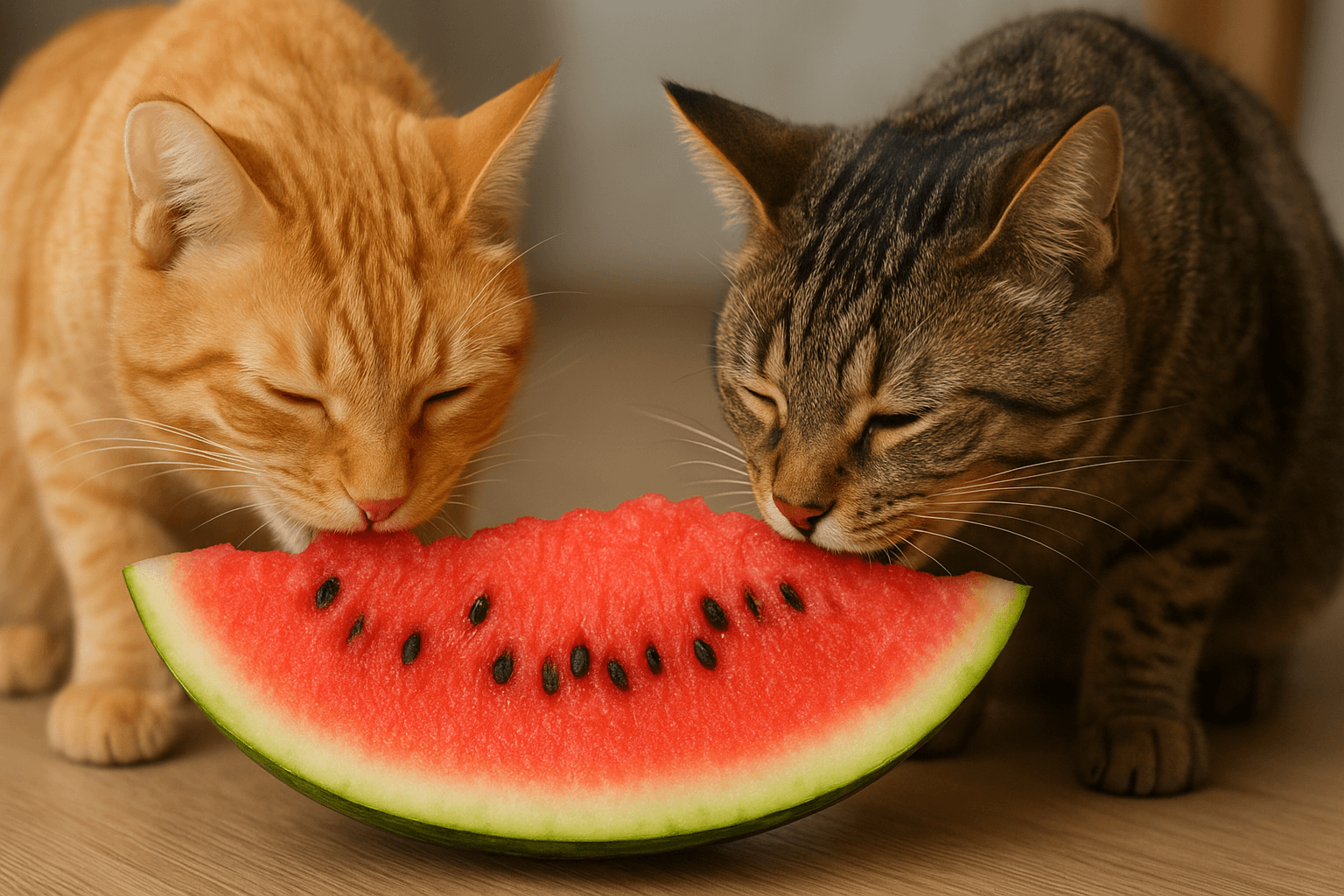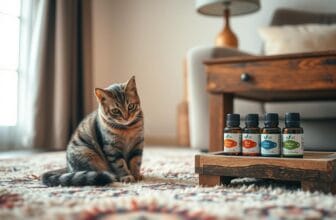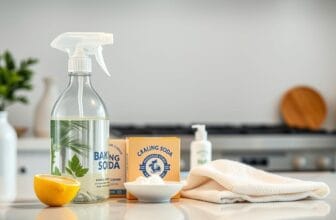
Table of Contents
Did you know your home might be full of dangers for your cat? Every year, many cats get sick from household chemicals. Often, their owners don’t even know it’s happening.
Cats love to explore and can get into trouble. They might find things in your home that are harmful to them. This can lead to serious health problems.
Things like cleaning supplies and everyday items can be toxic. Your home might have hidden dangers that can hurt your pet. It’s important to know what these are.
Knowing about these dangers helps keep your cat safe. This guide will show you which household chemicals are harmful. It will also give you tips to protect your pet.
Understanding the Vulnerability of Cats to Household Toxins
Cats are very sensitive to household chemicals because of their small size and unique metabolism. This makes them vulnerable to toxins. It’s important to know how to protect your cat’s health.
Cats are different from other animals because of their biology. Their small bodies and metabolism make them more sensitive to toxins.
Why Cats Are More Susceptible to Chemical Exposure
Cats have traits that make them more likely to get exposed to chemicals:
- Smaller body mass means toxins concentrate more quickly
- Lower enzyme levels for detoxification
- Higher metabolic rate accelerates chemical absorption
- Less efficient liver detoxification mechanisms
How Cats’ Metabolism Affects Toxin Processing
Cats have special challenges with toxins because of their metabolism. Their liver doesn’t have the enzymes to break down chemicals like humans and dogs do. This makes them more vulnerable to toxins for a longer time.
| Metabolic Factor | Impact on Toxin Processing |
|---|---|
| Enzyme Deficiency | Slower chemical breakdown |
| Body Weight | Faster toxin concentration |
| Metabolic Rate | Rapid chemical absorption |
The Role of Grooming in Chemical Exposure
Cats’ grooming habits increase their risk of chemical exposure. When chemicals settle on fur, cats inadvertently ingest these substances during self-cleaning. This creates a direct way for toxins to get into their bodies.
“A cat’s grooming behavior transforms environmental chemicals into potential internal health threats.” – Veterinary Toxicology Research
To protect your cat, you need to understand their unique vulnerabilities. Create a chemical-free environment for them.
Common Cleaning Products That Threaten Your Cat’s Health
Your home’s cleaning arsenal might be a silent threat to your feline friend. Toxic cleaning products cats encounter daily can pose serious health risks. Many pet owners overlook these dangers. Knowing which household cleaners cats are most vulnerable to can help you create a safer environment.
Many common cleaning products contain dangerous chemicals. These chemicals can harm your cat’s delicate system. Ingredients like bleach, ammonia, and formaldehyde can cause health problems. These include liver damage, respiratory issues, and long-term illness.
- Bleach-based cleaners
- Ammonia solutions
- Chlorine-based products
- Glycol ether cleaners
- Formaldehyde-containing solutions
Safe cleaning cat owners should know the risks of different household chemicals. Cats are especially vulnerable because of their grooming habits and smaller body mass. This makes them more susceptible to toxic exposure.
| Cleaning Product | Potential Health Risks for Cats |
|---|---|
| Bleach Cleaners | Respiratory damage, skin irritation |
| Ammonia Solutions | Lung inflammation, chemical burns |
| Formaldehyde Products | Cancer risk, neurological problems |
Prevention is key when protecting your cat from toxic cleaning products. Always store chemicals in secure cabinets. Use pet-friendly alternatives and ensure proper ventilation during cleaning.
Your cat’s health depends on the cleaning choices you make in your home.
The Hidden Dangers of Laundry and Dishwashing Products
Your cat’s safety is not just about food and toys. Laundry detergent can be harmful, especially through contaminated bedding and clothes. It’s important to know these risks to keep your cat safe.
Many pet owners don’t think about the chemicals left by regular laundry products. These chemicals can be very dangerous for cats. Cats often knead, sleep, or groom on fabrics, which can expose them to these dangers.
Detergent Residues on Pet Bedding
Standard laundry detergents have chemicals that can harm cats. These chemicals stay on pet bedding and can cause health problems:
- Skin irritation and allergic reactions
- Respiratory problems from chemical vapors
- Potential toxic ingestion during grooming
Safe Alternatives for Laundry Care
Keep your pet safe by using cat-friendly laundry products. These products are made to reduce chemical exposure:
| Product Type | Benefits | Recommended Brands |
|---|---|---|
| Hypoallergenic Detergents | Reduced chemical content | Seventh Generation, Method |
| Natural Fabric Cleaners | Plant-based ingredients | Ecover, Mrs. Meyer’s |
| Pet-Specific Laundry Solutions | Designed for animal bedding | Puracy Natural, Nature’s Miracle |
Always rinse pet bedding thoroughly. Consider an extra rinse cycle to remove chemicals. Your cat’s health depends on choosing the right products and cleaning them well.
Bathroom Chemical Hazards: From Toilet Cleaners to Air Fresheners
Your bathroom can be a danger zone for cats. They face risks from bathroom chemicals every day. Toilet cleaners, in particular, can be very harmful to cats.
Cats are at risk because of how they groom themselves. If they walk on a clean surface or drink from the toilet, they can get very sick.
- Toilet bowl cleaners with strong chemicals
- Air freshener risks cats frequently encounter
- Disinfectant sprays and cleaning solutions
“Prevention is always better than treatment when it comes to protecting your feline friend from toxic bathroom chemicals.” – Veterinary Toxicology Expert
Air fresheners can harm cats’ lungs and health over time. Plug-in air fresheners and aerosol sprays can release toxic vapors that compromise your cat’s delicate respiratory system.
| Chemical Type | Potential Risks to Cats | Recommended Action |
|---|---|---|
| Toilet Bowl Cleaners | Chemical burns, digestive issues | Use pet-safe alternatives |
| Air Fresheners | Respiratory problems, neurological impacts | Opt for natural ventilation |
| Disinfectant Sprays | Skin irritation, poisoning | Keep cats away during cleaning |
To keep your cat safe, store chemicals in locked cabinets. Make sure there’s good air flow. Pick cleaning products that are safe for pets and limit their exposure to harmful stuff.
Kitchen Chemicals and Food-Related Toxins
Your kitchen can be full of dangers for curious cats. It’s important for pet owners to know about kitchen toxins. Many everyday items, like cleaning solutions and food, can harm your cat.
To keep your kitchen safe for cats, you need to be careful. Cats are at risk because of their grooming and sensitive metabolism.
Cleaning Solutions in Food Preparation Areas
Kitchen cleaning products can be very dangerous for cats. Some of the biggest risks include:
- Disinfectant sprays
- Bleach-based cleaners
- Surface sanitizers
- Dish detergents
Make sure your cat is not around when you use these products. Also, keep chemicals in sealed cabinets where your cat can’t get them.
Toxic Food Items to Keep Away from Cats
Some foods are very bad for cats and should never be given to them:
- Chocolate – Contains theobromine, which is toxic to cats
- Onions and Garlic – Can damage red blood cells
- Grapes and Raisins – Can cause kidney failure
- Alcohol – Extremely dangerous even in small amounts
Protecting your cat starts with awareness and prevention.
If you think your cat has eaten something toxic, call your vet right away. Quick action can help prevent serious health problems.
Household Chemicals Toxic Cats: Essential Safety Guidelines

Keeping your cat safe from harmful chemicals is key. Cats are curious and can easily find dangerous stuff. They might not even know it’s risky.
“Prevention is always better than treatment when it comes to protecting your cat from household chemical exposure.” – Veterinary Safety Expert
There are important steps to keep your cat safe from chemicals:
- Store all cleaning products in locked cabinets
- Use pet-safe cleaning solutions whenever possible
- Keep medications and chemicals out of your cat’s reach
- Secure garbage bins with tight-fitting lids
- Check household plants for potential toxicity
Preventing chemical harm starts with a safe home. Cats can get sick from touching, breathing, or licking harmful stuff. This can happen through direct contact or by grooming dirty surfaces.
It’s up to you to keep your home safe. Check where chemicals are stored often. Always read labels to know if they’re safe for pets. Think about using natural cleaners instead. They clean well without harming your cat.
Remember: A few simple precautions can significantly reduce the risk of accidental chemical exposure for your beloved feline companion.
Garden and Outdoor Chemical Threats
Your outdoor spaces can hide dangers for cats. Garden chemicals can be very harmful. It’s important to keep your cat safe from these dangers.
Outdoor areas have many chemicals that can harm your cat. Knowing these risks helps keep your pet safe.
Fertilizers and Pesticides: Silent Threats
Chemicals used in gardens are dangerous for cats. These include:
- Herbicide sprays
- Insecticide granules
- Slug and snail baits
- Rodent control products
Cats can get these chemicals on their skin or by grooming. Metaldehyde-based products are especially toxic and can harm their brains.
Antifreeze Poisoning: A Deadly Risk
Antifreeze poisoning is a big danger for cats. Antifreeze tastes sweet to cats, making it a risk for them to drink it. Even a little can hurt their kidneys and be deadly.
To keep your cat safe, do the following:
- Clean up spills right away
- Keep chemicals in sealed containers
- Keep cats inside when chemicals are used
- Use safe alternatives when you can
If you think your cat has been poisoned, call your vet.
Medication and Healthcare Product Risks
Keeping your cat safe from medication is very important. Many human drugs can harm or even kill cats. It’s key to know the dangers of over-the-counter drugs for cats.
Acetaminophen is a big risk for cats. Just one tablet can cause serious health problems. Cats metabolize drugs differently, making them more at risk.
- Acetaminophen can destroy red blood cells in cats
- Prescription medications may cause severe organ damage
- Some human drugs can lead to respiratory failure
Vets say to keep all meds away from cats. Cats might find and eat pills left out. This could be very dangerous.
Always consult your veterinarian before administering any medication to your cat.
Here are ways to prevent medication toxicity in cats:
- Store medications in closed cabinets
- Never give human prescriptions to pets
- Keep pill bottles sealed and out of reach
- Immediately clean up any dropped medications
If you think your cat ate human medicine, call your vet right away. Quick action can stop serious health issues.
Air Quality Concerns: Chemical Vapors and Fumes
Your cat’s health is linked to the air they breathe indoors. Chemical fumes can be dangerous, and many pet owners don’t know about it. It’s important to understand these risks to keep your cat safe.

Indoor spaces can be toxic for cats. Their small size and metabolism make them more susceptible to harmful air. It’s crucial to be aware of these dangers.
Effects of Formaldehyde and VOCs
Volatile organic compounds (VOCs) are a big problem for cats. They come from many sources in the home:
- New furniture and carpets
- Paint and building materials
- Cleaning products
- Air fresheners
Formaldehyde, a VOC, can cause serious health issues in cats. These include breathing problems and long-term damage to cells.
Ventilation and Air Purification Solutions
To keep your cat safe from harmful fumes, you need to take action:
- Get high-quality air purifiers with HEPA filters
- Make sure your home has good ventilation
- Use low-VOC products
- Keep your home clean and dust-free
| Air Pollutant | Primary Sources | Potential Cat Health Risks |
|---|---|---|
| Formaldehyde | Furniture, carpets | Respiratory issues |
| Benzene | Paint, glues | Cellular damage |
| Trichloroethylene | Cleaning products | Organ stress |
Being careful and making smart choices can help keep your cat safe from harmful vapors. This protects their health for the long term.
Safe Storage Practices for Household Chemicals
Keeping your cat safe from harmful chemicals is key. Cats are curious and can get into trouble if chemicals are not stored safely. It’s important to know how to manage toxic substances to keep your home safe.
Creating a safe space for your cat means more than just hiding chemicals. You need a solid plan to avoid poisoning risks.
- Use locked cabinets with child-proof and cat-resistant latches
- Store chemicals on high shelves out of your cat’s reach
- Keep original containers sealed and intact
- Separate cleaning products from pet areas
Here are some important tips for storing household chemicals:
| Chemical Type | Recommended Storage Location | Safety Precaution |
|---|---|---|
| Cleaning Solutions | Locked Upper Cabinet | Secure with childproof lock |
| Pesticides | Garage or Shed | Sealed container, elevated storage |
| Automotive Fluids | Locked Storage Cabinet | Keep away from pet access |
Always read the instructions on chemical products for the right storage tips. Proper storage is your best defense against toxic exposure for your cat.
Remember: Prevention is always better than emergency treatment when it comes to your cat’s safety.
Emergency Response to Chemical Exposure
When your cat gets exposed to chemicals, fast action is key. Knowing how to handle a cat poison emergency can save their life. It can turn a small issue into a serious one.
First aid for chemical exposure is urgent and must be done carefully. Make sure to protect yourself by wearing gloves and keeping the area well-ventilated. This is before you even touch your cat.
Immediate First Aid Steps
- Remove your cat from the chemical exposure area immediately
- Prevent your cat from grooming or licking contaminated areas
- If chemicals are on fur, carefully wash with lukewarm water
- Do not induce vomiting unless instructed by a professional
Veterinary Care Toxicity Protocol
Call your vet or an animal poison control center right away. You’ll need to give them important details:
- Type of chemical involved
- Amount of exposure
- Time since exposure occurred
- Your cat’s current symptoms
Have emergency numbers ready and easy to find. Getting professional help is vital. It helps manage the chemical toxicity and prevents long-term health issues.
Remember: Quick action and professional guidance are your best defense in a chemical exposure emergency.
Natural and Pet-Safe Alternatives to Common Chemicals
Keeping your cat safe from harmful chemicals doesn’t mean a dirty home. Natural cleaning products for cats are safe and work well. Switching to eco-friendly cat care makes your home healthier for your cat.
Finding pet-safe household items is simpler than you think. Kitchen ingredients can make strong cleaners. These keep your home clean without harming your cat.
- Vinegar: A multipurpose natural cleaner
- Baking soda: Neutralizes odors and removes stains
- Lemon juice: Natural disinfectant and degreaser
- Hydrogen peroxide: Safe alternative for tough stains
Making your own cleaners is both affordable and safe. Homemade cleaners avoid toxic chemicals that can hurt your cat’s sensitive body.
| Ingredient | Cleaning Use | Cat Safety |
|---|---|---|
| White Vinegar | All-purpose surface cleaner | Completely safe when diluted |
| Baking Soda | Carpet and furniture deodorizer | Non-toxic and pet-friendly |
| Castile Soap | Gentle floor and surface cleaning | Natural and chemical-free |
“The best protection for your cat is prevention through natural, safe cleaning methods.” – Veterinary Wellness Magazine
When picking eco-friendly cat care products, always check the labels. Talk to your vet too. Some essential oils and natural products can still be dangerous to cats. So, it’s important to do your research.
Recognizing Signs of Chemical Poisoning in Cats
As a cat owner, knowing about cat poisoning symptoms is key to saving your pet. Chemical exposure can cause a range of toxic signs that need quick action. Spotting these changes early can be a lifesaver.
Chemicals can harm cats fast, so it’s vital to spot toxic signs quickly. Cats process chemicals differently than humans, making them more at risk from household items.
Physical Symptoms of Chemical Poisoning
- Persistent vomiting
- Dramatic changes in urine color
- Sudden lethargy or weakness
- Uncontrolled seizures
- Excessive drooling
- Difficulty breathing
Behavioral Changes Indicating Toxicity
Cats may show subtle changes when poisoned by chemicals. Look out for these important warning signs:
- Unusual hiding or isolation
- Dramatic personality changes
- Reduced appetite
- Unusual aggression or distress
- Disorientation or uncoordinated movements
If you think your cat has been exposed to chemicals, call your vet right away. Quick action is crucial when dealing with potential poisoning in cats.
Prevention Strategies and Home Safety Measures
Keeping your cat safe from household chemicals is crucial. It starts with understanding risks and taking steps to protect your home. This way, you can prevent poisoning and ensure your cat’s safety.
To make your home safe for your cat, follow these important steps:
- Regularly check your home for safety hazards
- Lock away chemicals in secure places
- Use child-proof locks on cabinets
- Remove toxic plants and substances
Protecting your cat is more than just storing chemicals safely. You must also teach everyone in your home about the dangers of chemicals. Awareness is your first line of defense against accidental poisoning.
Here are key steps for preventing poisoning in pets:
- Keep cleaning products in locked cabinets
- Store medications in sealed containers
- Clean spills right away
- Use pet-safe cleaning alternatives
A vigilant pet owner is a cat’s best protection against household chemical risks.
By watching your cat closely and acting fast, you can avoid health emergencies. These steps help make your home a safer place for your furry friend.
Creating a Cat-Safe Home Environment

Creating a safe home for cats needs careful planning. It’s important to use pet-proofing techniques to keep your cat safe. Your home should be both secure and comfortable for your cat, supporting their natural behaviors.
Look at your home from your cat’s point of view. Find dangerous spots and add safety measures. Making your home cat-friendly means more than just removing dangers. It’s about creating a space where your pet can be happy and safe.
- Remove toxic plants and secure loose electrical cords
- Choose pet-safe flooring materials
- Create designated safe spaces for your cat
- Use non-toxic cleaning products
Be careful when bringing new things into your home. New furniture, carpets, and textiles can release harmful chemicals. Let these items air out in a well-ventilated area before using them. This helps keep your cat safe from harmful vapors.
“A safe home is a happy home for both cats and their humans.” – Veterinary Safety Expert
Good air flow is key to a safe home for cats. Open windows often and use air purifiers with HEPA filters. These steps help keep your home air clean for your cat.
- Install window screens to prevent escape
- Keep cleaning chemicals in locked cabinets
- Create vertical spaces for climbing and exploration
Remember, keeping your home safe for your cat is an ongoing task. Always check your home’s safety and make changes as needed to keep your cat safe.
Conclusion
Your cat’s safety is up to you. Knowing about toxic dangers is key. Everyday items like cleaning products and garden treatments can be harmful.
Understanding these risks is the first step. We’ve covered how to keep your home safe for your cat. Every room has its own dangers, so it’s important to check everything carefully.
Keeping your cat safe is a big job. You need to always be learning and ready to change. Look for pet-safe products and read labels well. This way, you can make your home a safe place for your cat.
Preventing harm is better than treating it. Being aware and taking action is the best way to protect your cat. Start now to make your home a safer place for your cat.
FAQ
How quickly can household chemicals harm my cat?
Cats can get sick from toxic chemicals in minutes to hours. This depends on the chemical and how they come into contact with it. Signs include vomiting, trouble breathing, or acting differently. Some chemicals can harm your cat for a long time, even with a little exposure.
What are the most dangerous household chemicals for cats?
Some very harmful chemicals include bleach, ammonia, and formaldehyde. Also, essential oils, pesticides, and some cleaning products are dangerous. Antifreeze is especially bad because it can be deadly in small amounts. Keep these chemicals locked up and away from your cat.
How can I tell if my cat has been exposed to toxic chemicals?
Look for signs like a lot of drooling, vomiting, or acting tired. They might also have trouble breathing, shake, have seizures, or change how they pee. Some cats might hide more, eat less, or meow differently. If you think they’ve been exposed, call your vet right away.
Are natural cleaning products completely safe for cats?
No, not all natural products are safe for cats. Essential oils, for example, can be very toxic. Always check the ingredients and talk to your vet before using new cleaning products around your cat.
How can I make my home safer for my cat?
Make your home safe by keeping chemicals in locked cabinets. Use child-proof latches and keep cleaning products out of reach. Choose pet-safe cleaning products. Check your home for dangers and teach everyone to keep toxic stuff away from your cat.
What should I do if I suspect my cat has been poisoned?
Get your cat away from the danger right away. Gather info about the poison and call your vet or the ASPCA Animal Poison Control Center. Don’t try to make them vomit unless a vet tells you to. Quick action is key.
Are there any safe alternatives to chemical cleaning products?
Yes! Use vinegar, baking soda, and other natural cleaners. Look for cleaning products that are safe for pets. Always air out your home well after cleaning and keep your cat away during and after.
Can chemical exposure cause long-term health issues in cats?
Yes. Chemicals can cause long-term health problems like breathing issues, kidney damage, and even cancer. Even small amounts can add up and cause big health problems over time.
How sensitive are cats to chemical vapors?
Cats are very sensitive to chemical vapors because of their small size and special breathing system. They can get sick from vapors in new furniture, paint, and cleaning products. They also get chemicals on their fur and might eat them.
What common household items are surprisingly toxic to cats?
Many everyday items can be harmful, like certain plants (like lilies), human medicines, chocolate, onions, garlic, and some air fresheners. Always check if something is safe for your cat and keep dangerous items away.







